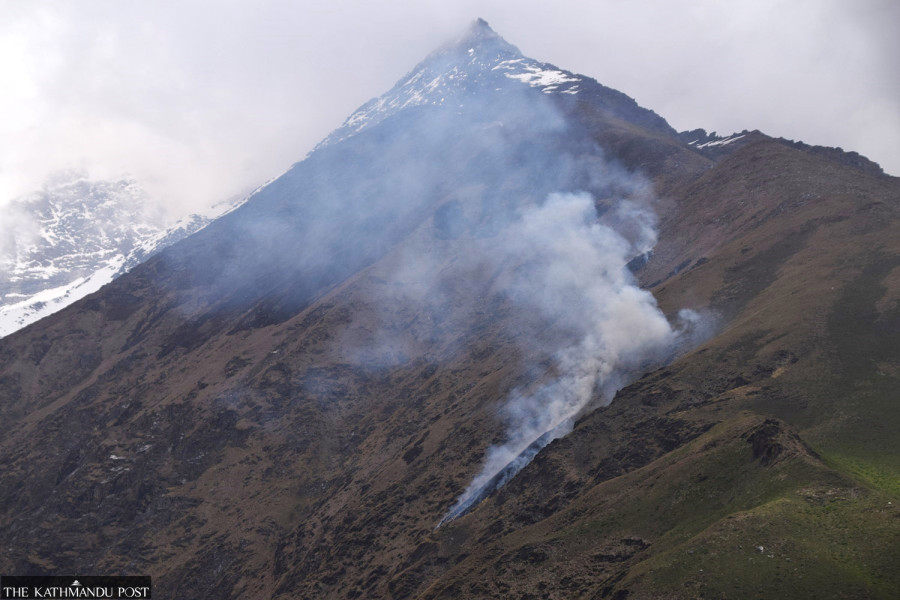Climate & Environment
Wildfires in Bajhang highlands destroy biodiversity
Despite frequent wildfires in the uplands of the district, no scientific studies have been conducted in the region.
Basant Pratap Singh
Sinki Bohora of Surma Rural Municipality in Bajhang district went missing in an avalanche at Byasimare highland on June 2. Bohora, who had reached the highland to collect yarsagumba, was in her tent along with her 13-year-old son and 16-year-old nephew. Bohora’s son and nephew were able to run to safety when the avalanche hit but Sinki got swept away along with the tent.
Sinki’s family have been setting up tents in the same place during the yarsa picking season for the past 11 years. This is the first time an avalanche was reported in the area.
Ramesh Bohora, Sinki’s relative, claims that the avalanche was caused by a wildfire that had been raging in a nearby pine forest.
“A big wildfire was raging in the pine forest just above the place where the avalanche occurred,” said Ramesh. “I believe the heat from the fire caused the snow to melt, which led to the avalanche.”
Ramesh said that the wildfire had been raging at a 1.5 km radius of the pine forest for four days prior to the avalanche.
Experts agree with the locals and attribute the avalanche to wildfires near the snow-capped highlands.
Mountain expert and dean of Science and Technology Faculty of Mid-Western University Dr Sandip Thakuri said that the June 2 avalanche might have occurred due to the rise in wind temperature following the wildfire in the highland region.
“There are small valleys and gorges near the mountains. When a wildfire breaks out, heat gets trapped in the deep gorges and valleys which raises the temperature in the area. The heat triggers an unnatural snow melt that leads to avalanches,” said Thakuri.
Thakuri said that such incidents have long-term effects on the highland region.
“Wildfires play a major role in escalating the snow melting process as the carbon emitted during the wildfires accumulates in the mountains, which increases the rate of heat absorption,” said Thakuri.
The wildfires in the highlands not only lead to a frequent occurrence of avalanches but also pose a great risk to the ecology and biodiversity of the Himalayan region. Wildfires destroy the forests, herbs and wildlife and also affect the locals living in the highland areas who depend on the natural resources for their livelihood.
Around a dozen forest and bush areas in Surma Rural Municipality, including Gaisera, Tapoban, Delthela, Chandeshikhar, Byasimare, Sunkhani and Jaljala, among others, were experiencing wildfires during the first week of June. These wildfires turned lush green forest areas to ashes.
Wildfires broke out in most of the highland areas in Bajhang in May-June this year.
“Wildfires start in the mountain region in April-May. People from the lowlands start heading to the highlands to collect yarsagumba during this time and start wildfires at various places,” said Subas Bohora, a resident of Saipal Rural Municipality. “This is not the first time that wildfires have been recorded; this phenomenon occurs every year.”
According to the records at the Forest and Land Conservation Department under the Forest and Environment Ministry, the Wildfire Monitoring System has recorded forest fires in 48 places in Bajhang between May and June this year. Last year, the system recorded 290 wildfires in the district. These are just the records that were identified using satellite imagery which only captures wildfires under the 100 metre grid, excluding small forest fires that are shielded by hillsides or gullies.
The yearly wildfires that occur in Bajhang, which has around 30 percent of its land in the mountain region, have had adverse effects on both plant and animal life. The forest areas in the district, which lie 4,000 metres above the sea level, are home to some exotic wildlife, including Musk Deer, Himalayan Thar, Himalayan Blue Sheep, and Snow Leopard, among others. Protected birds, including Danphe and Himalayan Monal, are also found in these high-altitude areas. However, the number of these animal and bird species has decreased in the past few years.
“Earlier, we used to see flocks of Danphe and Himalayan Monal flying nearby while Musk Deer, Himalayan Thar and Blue Sheep sightings were also common in the highlands during yarsa season,” said Man Bahadur Singh, a yarsa collector from Jaya Prithvi Municipality. “We don’t see them now. Instead, we see burnt nests of birds along with their eggs and chicks at various places.”
Although coordinated wildfires are common near human settlements to increase the yield of grass, people have been setting fires in the forest areas for no reason, local residents say.
“Sometimes people who go into the forest to collect herbs throw away a lighted cigarette butt which leads to a forest fire,” said Nawaraj Pujara of Surma. “Some people even set fire to the forest in a fit of rage when they do not find the desired herbs.”
Pujara further said that hunters and poachers are also responsible for haphazard wildfires and there have been reports of fires in the forest during October-December when the herb collection season is over.
Despite frequent wildfires in the highlands of the district, no scientific studies have been conducted in the region. Local residents say it takes years for a forest to regrow after a wildfire.
“How will the wildlife and plants thrive when there is no forest?” said Runchhe Bohora of Saipal Rural Municipality. “When there is a wildfire, there is no shelter and food for the animals. The wildlife in the region is disappearing.”
Experts say that wildfires in the mountain region have a more lasting damage than in other regions since most of the plant and animal species found in the region are listed either as near threatened, vulnerable, endangered or critically endangered categories.
“In terms of biodiversity, the mountain region is home to some of the most important and exotic plants and wildlife. A wildfire in the region can cause irreparable damage which cannot be undone as the region, despite covering a small portion of the total land, is home to a large number of diverse plant and animal species,” said Tribhuvan University Botany Department Associate Professor Dr Narayan Ghimire.
Ghimire said that in the hills or the plains, a plant can grow upto a metre in height in one year but it takes at least 10-15 years for any plant to achieve that height in the mountain region.
“A wildfire in the mountain region can render some of the plant life to extinction. Starting a wildfire in a region that has exotic biodiversity is a crime and this should be stopped,” said Ghimire.
Haphazard wildfires have not only caused the loss of wildlife and plants but have also cost the livelihoods of the locals who depend on the forest. Locals say the availability of herbs, including yarsagumba, has significantly decreased with the increase in the number of wildfires over the years. With the decrease in the herb yield, many locals are migrating to neighbouring India in search of work.
Traders who deal in herbs say that just 10 years ago herb trade would bring in a revenue of Rs 1 billion in Bajhang district. The amount has now decreased to Rs200-250 million, said Dan Bahadur Surmeli, chairman of the Bajhang Chapter of the Chamber of Commerce and Industry.
“Yarsagumba yield in Bajhang’s highlands has declined over the years and this has resulted in a decline in trade,” said Surmeli, who also trades in herbs. “The herb trade will continue to decrease in the coming years.”
Meanwhile, no authorities have turned their attention to controlling the wildfires that are set without any reason.
Purna Bahadur Khati, chief at the Forest Division Office, said that although his office is aware of wildfires that are set haphazardly, no effort has been made to control them.
“Although we know that wildfires are on the rise, there aren't any programmes to control them,” said Khati. “Raising awareness among the herb collectors could help mitigate the situation as the forest office does not have the adequate human resources to monitor and take action against those involved in setting forests on fire.”
“Maybe the local units can do something about it,” he added.
However, the local units themselves have no clue on how to control the haphazard wildfires.
“Forest areas are being destroyed by unplanned wildfires. If this continues, there won’t be any plant life left in the mountain region,” said Khadka Bohora, an official at a local unit in Bajhang. “We are working on raising awareness to mitigate the risk of wildfires.”
Khadka said that the local unit will make concrete efforts to control such incidents before the next herb collection season.




 14.12°C Kathmandu
14.12°C Kathmandu











